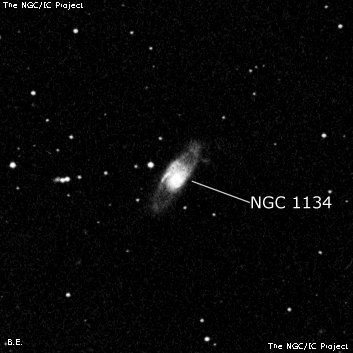
William Herschel discovered NGC 1134 = H II-254 on 16 Oct 1784 (sweep 295) and recorded "F, S, iR, r". His position is 2.3' SE of Arp 200 = PGC 10928, and there are no other nearby candidates. Dreyer, using Lord Rosse's 72", recorded "L, irr R, perhaps sharper on nf side". This probably refers to the brighter arm segment on the east side.
400/500mm - 17.5" (10/21/95): faint, moderately large, edge-on 5:1 NNW-SSE, 1.8'x0.3', broad weak concentration. Located 10.3' SSE of NGC 1134.
17.5" (10/21/95): fairly faint, fairly small, slightly elongated NW-SE, 1.0'x0.8', broad concentration with a large brighter core. A mag 13 star is 48" ENE of center. Located 11' ENE of mag 8.9 SAO 93163. Brightest in a group with IC 267 10.3' SSE and NGC 1127 19' NW. The larger low surface brightness spiral arms extending the diameter to over 2' were not seen.
600/800mm - 24" (12/21/16): at 282x; fairly bright, moderately large, elongated 2:1 or 5:2 NW-SE, ~1.2'x0.6', sharply concentrated with a bright core and fairly bright, sharp stellar nucleus. Appears slightly brighter along the east edge with averted -- probably a section of the eastern spiral arm, which is bright on the DSS. A mag 13.6 star is 50" NE of center. IC 267 is 10' SSE and UGC 2362 is 7' W.
Arp noted "Splash appearance on west side [tidal plume] of galaxy points to low surface brightness companion 7' [west]." The companion he referred to is UGC 2362, which is possibly interacting (the pair has identical redshifts). UGC 2362 appeared faint, fairly small, very low surface brightness patch ~20" diameter (probably the brighter central part of this Magellanic system). A mag 14.8 star is 0.8' S. IC 267 appeared moderately bright, relatively large, elongated ~4:1 NNW-SSE, ~1.7'x0.4', irregular surface brightness. This appears to be a central bar (verified on the DSS) rather than an edge-on galaxy. Either a star is superimposed at the center or the galaxy has a bright stellar nucleus! Located 10' SSE of NGC 1134.
Notes by Steve Gottlieb